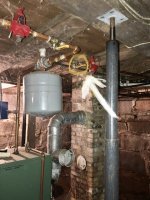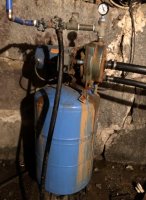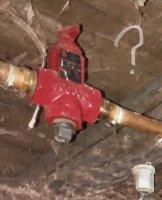newfarmer
New Member
Relatively newbie homeowner of an older 70s home with a pump and compressor tank and two hoses (one large, one smaller) that go down to the well. It's noisy, when the pump kicks in, sending out a high-pitched whining noise that can be heard on the 2nd floor. Not great water pressure and loud, but it's been working okay for a few years.
Flash forward to last week. We lost power for four days from a snowstorm, which meant I had to prime the pump, which I've done before. It seemed to take a lot of water to accomplish this time, but it eventually kicked in (though seemingly not as dramatically as it did the other two times I've had to prime it). It was pouring rain all day when I did this, incidentally, so the cellar was pretty damp and the ground outside the house was soaked from the rain and melted snow.
The water that came out when the pump kicked in from priming was really dirty, but I thought that was maybe because of the rain runoff or something. Everything seemed to be working okay: water pressure, color didn't seem to be bad.
However, the pump started to cycle on every time we turned on the water and for as long as we ran the water. Sometimes it would kick on by itself but literally only for a second and then shut off. I changed the water filter. Read a bunch of websites. Checked over the tank. The pressure gauge never seems to change, always reading about 44 psi (measuring the water pressure or the air pressure? I don't know).
I called the plumber. He diagnosed a bad foot valve at the pump. Hiring someone with a mini excavator to dig it up and having the plumber fix it will total probably $1,500, worst-case scenario, he said.
Any suggestions? I'm wondering if the really dirty water didn't clog the compressor gauge sensor or something? A bad tank? But I looked over as much as I could with my very limited experience and the tank seems rusty but okay.
Any thoughts?
Flash forward to last week. We lost power for four days from a snowstorm, which meant I had to prime the pump, which I've done before. It seemed to take a lot of water to accomplish this time, but it eventually kicked in (though seemingly not as dramatically as it did the other two times I've had to prime it). It was pouring rain all day when I did this, incidentally, so the cellar was pretty damp and the ground outside the house was soaked from the rain and melted snow.
The water that came out when the pump kicked in from priming was really dirty, but I thought that was maybe because of the rain runoff or something. Everything seemed to be working okay: water pressure, color didn't seem to be bad.
However, the pump started to cycle on every time we turned on the water and for as long as we ran the water. Sometimes it would kick on by itself but literally only for a second and then shut off. I changed the water filter. Read a bunch of websites. Checked over the tank. The pressure gauge never seems to change, always reading about 44 psi (measuring the water pressure or the air pressure? I don't know).
I called the plumber. He diagnosed a bad foot valve at the pump. Hiring someone with a mini excavator to dig it up and having the plumber fix it will total probably $1,500, worst-case scenario, he said.
Any suggestions? I'm wondering if the really dirty water didn't clog the compressor gauge sensor or something? A bad tank? But I looked over as much as I could with my very limited experience and the tank seems rusty but okay.
Any thoughts?
Last edited:



